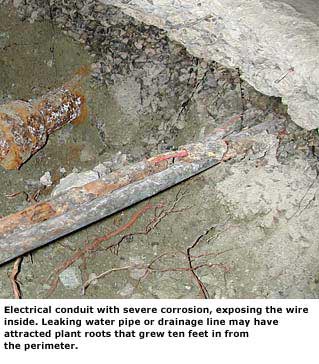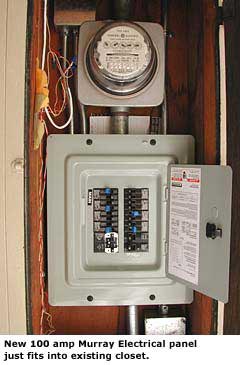Eichler Electrical
 Ethereal roofs that seem to 'float' above the house. Slab-on-grade foundations that connect the structure solidly to the earth. And walls of glass that bring the outdoors in.
Ethereal roofs that seem to 'float' above the house. Slab-on-grade foundations that connect the structure solidly to the earth. And walls of glass that bring the outdoors in.
All of these are hallmarks of the Eichler style, and all of them give homeowners headaches when electrical circuits fail and remodels require power that's up to modern standards.
Let's say you've decided it's time to build the kitchen of your dreams and replace those decades-old Formica countertops and vintage appliances with a complete kitchen remodel. While the existing electrical outlets may have served you well, current building codes require two separate small-appliance circuits (your original Eichler only had one such circuit) as well as individual circuits for the new built-in microwave and refrigerator.
That means three new circuits to the kitchen! How can an electrician get there with no attic and no sub-floor crawl space? While there is conduit running from the circuit box out by the garage to the kitchen, according to Chris Gay of AAA Christopher Electric, Inc. on the peninsula, it is very rare to successfully pull new wire through old subsurface Eichler conduit. Gay believes you only have two options: route conduit over the roof and drop it down, or run it outside the house along the base of the slab.
This results in a visual effect that is far from pleasing, but the only alternative is to coordinate that kitchen remodel with a roof replacement, at which time the new conduit can be laid underneath the roofing material, just as was done originally for the ceiling lights. In models where the kitchen is a free-standing central space that doesn't connect with an exterior wall or even the roof, the new circuits will need to be brought down from the roof through a metal pipe that can be matched in size and color to the existing drain pipe vent.
Bathroom remodels face a similar challenge. Current code requires that each bathroom have a dedicated circuit for wall receptacles, and original Eichler bathrooms share their power with other rooms. Don't blame Eichler; that's the way it was done in those days. Code now also requires GFC receptacles, but those are easily added to existing circuits, even ungrounded ones.
 Eichler electrical challenges aren't just triggered by remodeling projects. Circuit failures are not unusual, and since almost all wiring from the circuit box goes beneath the slab before surfacing at various points in the house, problems are invariably caused by metal corrosion. As Chris Gay explains, the old conduit is of the 'EMT' (electro metallic tubing) type, a thin wall tubing that has a limited subsurface life. Radiant or domestic water pipe leaks, or even roof downspouts that aren't properly directed away from the house, can introduce water below the slab, where vulnerable electrical conduit is located.
Eichler electrical challenges aren't just triggered by remodeling projects. Circuit failures are not unusual, and since almost all wiring from the circuit box goes beneath the slab before surfacing at various points in the house, problems are invariably caused by metal corrosion. As Chris Gay explains, the old conduit is of the 'EMT' (electro metallic tubing) type, a thin wall tubing that has a limited subsurface life. Radiant or domestic water pipe leaks, or even roof downspouts that aren't properly directed away from the house, can introduce water below the slab, where vulnerable electrical conduit is located.
Sometimes electrical conduits were originally run below the atrium patio to get from one wing of the house to the other as directly as possible. When they pass beneath an open planting area in the atrium, these conduits are directly exposed to frequent 'baths' when landscaping is watered, resulting in the virtually guaranteed destruction of the metal conduit. Circuit failures will inevitably follow. So, when troubleshooting, don't assume that all lines are beneath the slab. The good news is that if a future problem will be associated with the conduit running through the atrium, it will become much more accessible for repair.
Lack of grounding is another big problem common to all 1950s-era homes, and Eichlers are no exception. Modern electronics such as computers and stereo equipment can be sensitive to ungrounded circuits. Fortunately, this problem can be remedied by pulling a ground wire from the circuit through an exterior wall and driving a copper grounding stake deeply into the soil.
 "It's fairly significant to upgrade Eichler electricals," says Ron Key of Key Construction & Design. One area Key regularly deals with is replacing original electrical service panels, which typically were originally only 60 to 100 amps, with a modern panel that offers 125 to 200 amps. However, larger-capacity panels will require enlarging the closet space where the panel is located.
"It's fairly significant to upgrade Eichler electricals," says Ron Key of Key Construction & Design. One area Key regularly deals with is replacing original electrical service panels, which typically were originally only 60 to 100 amps, with a modern panel that offers 125 to 200 amps. However, larger-capacity panels will require enlarging the closet space where the panel is located.




